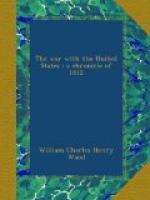Wool now re-formed his three hundred and ordered his gunners to drill out the eighteen-pounder and turn it against Queenston, where the British were themselves re-forming for a second attack. This was made by two hundred men of the 49th and York militia, led by Colonel John Macdonell, the attorney-general of Upper Canada, who was acting as aide-de-camp to Brock. Again the Americans were driven back. Again the gun was recaptured. Again the British leader was shot at the critical moment. Again the attack failed. And again the British retreated into Queenston.
Wool then hoisted the Stars and Stripes over the fiercely disputed gun; and several more boatloads of soldiers at once crossed over to the Canadian side, raising the American total there to sixteen hundred men. With this force on the Heights, with a still larger force waiting impatiently to cross, with twenty-four guns in action, and with the heart of the whole defence known to be lying dead in Queenston, an American victory seemed to be so well assured that a courier was sent post-haste to announce the good news both at Albany and at Dearborn’s headquarters just across the Hudson. This done, Stephen Van Rensselaer decided to confirm his success by going over to the Canadian side of the river himself. Arrived there, he consulted the senior regulars and ordered the troops to entrench the Heights, fronting Queenston, while the rest of his army was crossing.
But, just when the action had reached such an apparently victorious stage, there was, first, a pause, and then a slightly adverse change, which soon became decidedly ominous. It was as if the flood tide of invasion had already passed the full and the ebb was setting in. Far off, down-stream, at Fort Niagara, the American fire began to falter and gradually grow dumb. But at the British Fort George opposite the guns were served as well as ever, till they had silenced the enemy completely. While this was happening, the main garrison, now free to act elsewhere, were marching out with swinging step and taking the road for Queenston Heights. Near by, at Lewiston, the American twenty-four-gun battery was slackening its noisy cannonade, which had been comparatively ineffective from the first; while the single British gun at Vrooman’s, vigorous and effective as before, was reinforced by two most accurate field-pieces under Holcroft in Queenston village, where the wounded but undaunted Dennis was rallying his disciplined regulars and Loyalist militiamen for another fight. On the Heights themselves the American musketry had slackened while most of the men were entrenching; but the Indian fire kept growing closer and more dangerous. Up-stream, on the American side of the Falls, a half-hearted American detachment had been reluctantly sent down by the egregious Smyth; while, on the other side, a hundred and fifty eager British were pressing forward to join Sheaffe’s men from Fort George.




